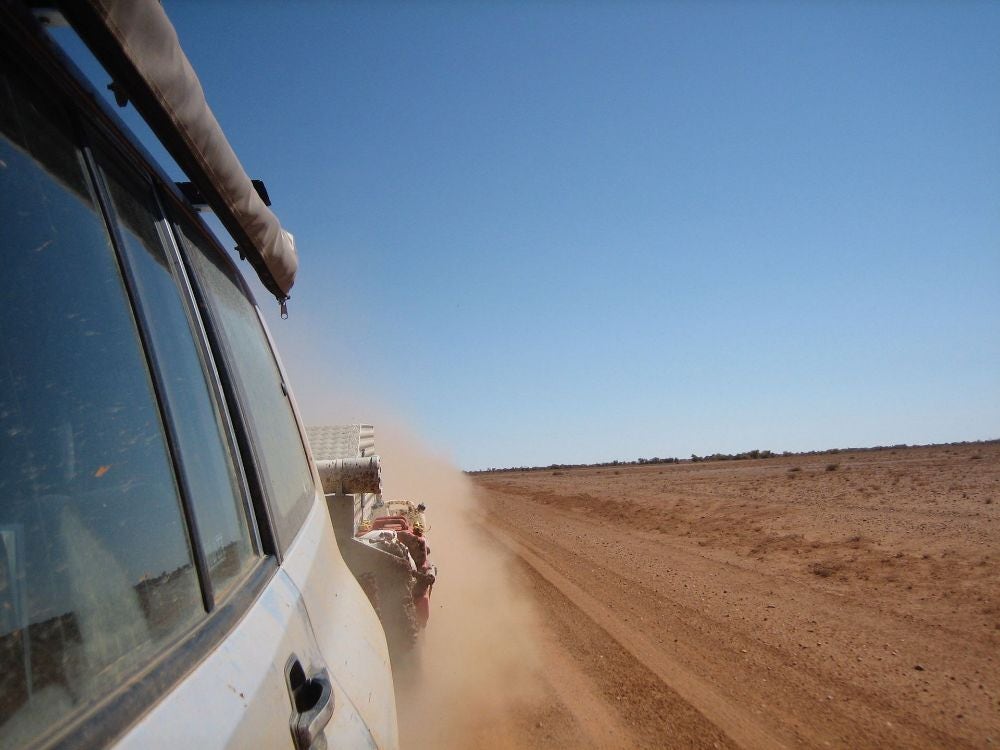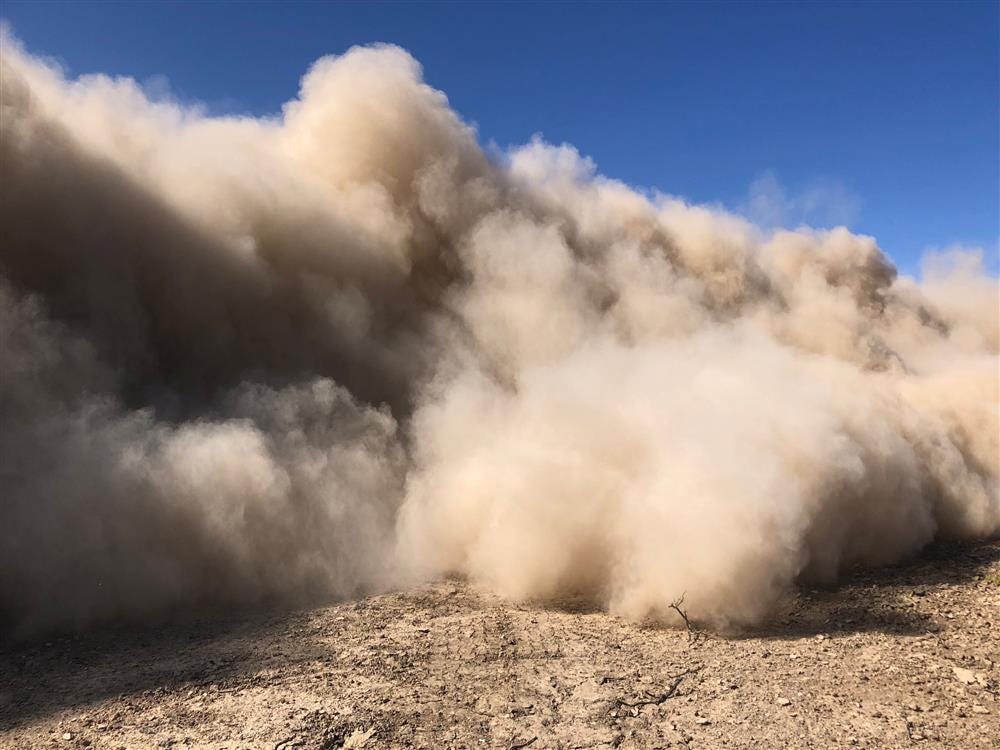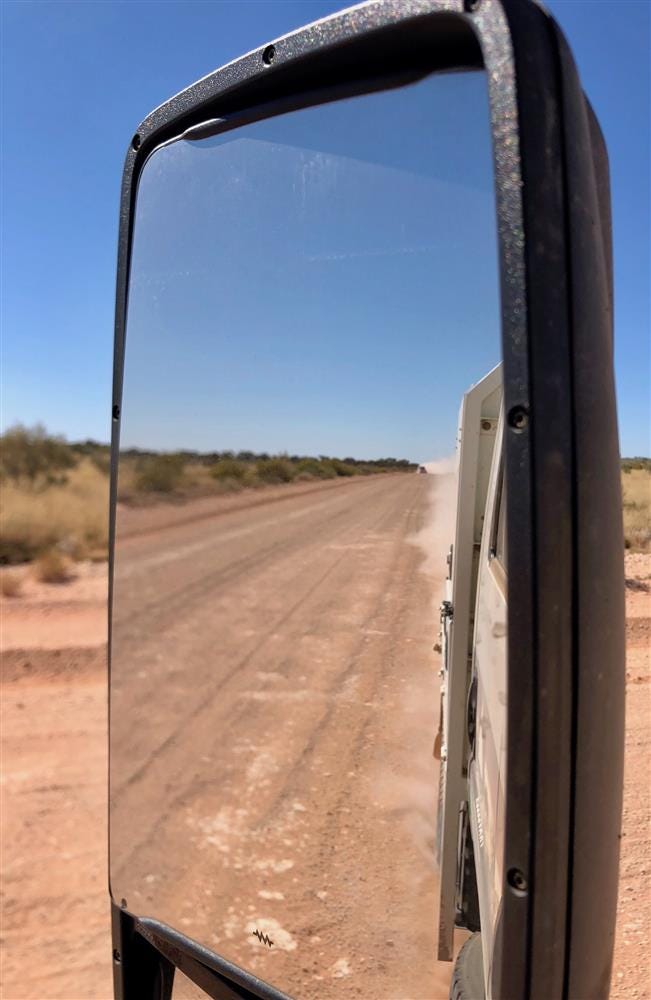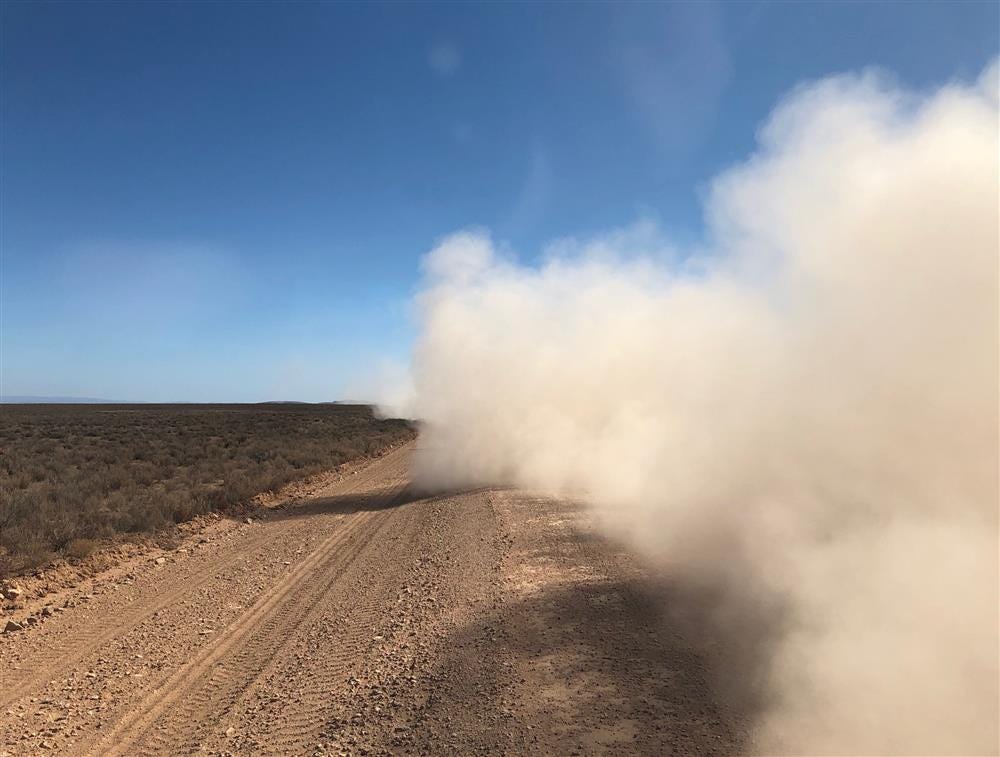

Andrew and Peta Murray from Top Wire Traveller travel all over Australia in their truck camper. They seek out the dirt roads, preferring them to the blacktop. Sometimes they see other drivers do some surprising things in the outback.
Here they explain why you should show other drivers some courtesy on dirt roads, and the best ways to do this.
Why you need to think of other road users
Do you like being showered with rocks, blinded by huge plumes of dust, even forced off the road? No, we don’t either!


Dirt roads are different to tar roads. You encounter dust, rocks, corrugations, potholes… all sorts of nasties. You need to change your driving style on dirt. Flat out and foot to the floor might work on tar, but it’s a recipe for disaster on dirt.
Many of us from the cities are aggressive drivers, mainly due to self-preservation. We drive around in our protective tin boxes, doing battle with the ever-growing congestion and aggression all around us.
Our tin box is our safe haven. We look through the windscreen like we’re watching a movie, viewing the traffic as a mass of vehicles, all trying to push in or cut us off… the aggressors, the enemy. We’ve forgotten there are people in those cars.
When you get out of the cities and onto the dirt roads, you’ll find a different mindset.
You’re in the country now. Relax! Show courtesy to other drivers. Slow down, take in the scenery and consider other road users.
Think about this. In the city if you cut someone off, chances are you’ll never see them again. You might even feel a bit clever, like you’ve had a small victory.
Not so in the bush.
The person you just showered in rocks or forced off the road with your aggressive overtaking manoeuvre? They might be the one you rely on to help you, when you’re broken down…
Once you’re in the bush, travellers rely on each other. Worst case, a life can depend on helping each other out.
What do you need to do? How should you behave when you’re driving on dirt roads?
How to behave when you’re driving on dirt roads
We’re not all maniacs when we get behind the wheel. Not at all. So let’s start at the other end of the scale.
Say you’re completely new to dirt road driving. You’re being super-careful, driving slowly and carefully. How can you help your fellow drivers?
Be aware of what’s around you
You’re nervous. The tar has turned to dirt and it’s pretty rough. This is your first time on a road like this, so you’re driving slowly. You focus on the road, scanning for those car-destroying corrugations and massive washouts you’ve read so much about.
But what’s behind you? You’re so busy looking ahead that you don’t look behind in your mirrors.
Suddenly a 4WD appears right beside your door, roaring past at breakneck speed. It disappears ahead in a shower of stones and a blinding cloud of dust.
What just happened?
They might have been sitting behind you for ages. Or they could be locals who drive this road every day, frustrated by the endless stream of slow travellers who hold them up.
Use your rear vision mirrors. Scan them constantly for vehicles approaching from behind. You might be kicking up plenty of dust, but there’s always opportunities to see what’s behind you.
A bend in the road, a change in wind direction, causeways… these are opportunities to get a good look at what’s behind you. Check your mirrors regularly. Even if you think you’re kicking up a huge dust cloud, keep glancing in your mirrors. At some stage, you will see a vehicle behind you.


If the vehicle’s a fair distance behind you (like the image above), simply pull over and let them past. It’s the safest way. If you don’t, the overtaking vehicle will either have to sit behind you or risk overtaking blind.
You don’t want to be a part of the latter. If they have a head-on, chances are you’ll be tangled up in the mess.
What if the vehicle is close behind?
Whatever you do, don’t stop quickly! Chances are they’ll run straight into the back of you. Turn on your left indicator and gradually slow down. Once the dust dies down, they’ll most likely overtake.
If you have a UHF, use it. Tell them you’ve seen them and you’re going to pull over to the left.
And if you’re the one caught behind a slower vehicle, stay back out of their dust. Call them up on your UHF. If you don’t have a UHF, wait for a safe opportunity to overtake. Don’t ever drive blindly through thick dust.
Size really does matter
On dirt roads or narrow one lane tar roads, there’s an unwritten rule you need to know about. You mightn’t like it, but this is the deal.
The smaller vehicle always gives way to the larger vehicle.
No ifs, buts or maybes. That’s just how it is. A triple road train trumps a double road train, a small truck trumps a 4WD, a 4WD trumps a sedan.
Commit this one to memory. It has nothing to do with ego, it’s simply common-sense.
Why is this the case? It’s all about safety. You might not think twice about dropping off the road in soft soil if you’re in a 4WD. But a truck can easily become bogged or dig in, then tip over.
Same goes if you’re towing a caravan with a 4WD and a small truck approaches. You might think you’re a bigger rig, but you’re not. It’s far easier for you to slow down than for the truck to slow down.
Be aware though, not everyone is aware of this common-sense rule.
We’ve encountered many much smaller vehicles than our truck, who tried to force right of way:
- A 4WD with a small camper trailer driving down the middle of a wide dirt road at us, then waving their fists because we didn’t pull over
- The couple in their Prado who drove straight at us on a single lane causeway, after we had started to cross first
- The hero in his on-coming 4WD, who tried to beat us to a narrow one lane bottleneck over a culvert.
I could go on, believe me…
Leave your ego at home. No one owns the road, it’s there to share.
Just keep in mind, the on-coming driver might not behave as expected. Back off and be ready to take evasive action. Don’t stress though, road hogs are a tiny minority. The vast majority of drivers are courteous and responsible.
Passing other vehicles
This one is simple. Slow down.
You don’t want to be showered with rocks and they don’t either. So slow down.


I have to mention a crazy technique promoted by some 4WD “experts” several years ago… and still used by some. You need to know about this.
These “experts” declared the safest way for two vehicles to pass on dirt, was to be as close to each other as possible. This way, there was less chance of stones from one vehicle hitting the other.
The idea was to be as close to the other vehicle as you could. This is ridiculous and extremely dangerous. DO NOT DO THIS!
Not only are you placing both vehicles in danger of a collision, but you’re trying to do it on an uneven and unpredictable road surface, at a closing speed of 150 – 200km/h! What happens if one of you hits a rut or a pothole? Chances are you’ll crash.
Unfortunately, this dangerous technique persists. You’ll occasionally find you’re being “chased” across the road by an on-coming car. The further you move to the left, the further they move right.
Not only is this disconcerting, it’s downright dangerous.
Helping out
If you see someone stopped on the side of an isolated road, stop and make sure they’re okay. Most of the time they’ll be fine. But occasionally they’re in trouble.
We encountered a couple who had run out of spare tyres. So we strapped their two blown out tyres on the truck and did a 300km round trip to get them replaced. Sometimes you just have to help each other out.
One tip. If you pull over for a break and everything’s okay, give an approaching vehicle the thumbs up. This indicates you’re okay and they don’t need to stop.


Camping areas and rest areas
When you’re in the outback, chances are the camping areas and rest areas will be dusty. When you drive in, slow down to reduce dust. Walking pace is a good guide.
No one likes being covered in clouds of dust. We’re probably all guilty of driving too fast in camping and rest areas. Just try to remember to slow down. After all, you might have to camp with these people!
In summary
Really, courtesy on dirt roads is just common-sense:
- Be aware of what’s behind you, as well as in front
- If someone wants to overtake, move to the left and slow down gradually. Wave them past, so they know your intentions
- If you’re following a slower vehicle, stay back out of their dust
- If you have a UHF, use it to contact the vehicle behind you (or in front)
- Give way to larger oncoming vehicles. Pull off the road and stop if you need to
- Slow down when passing an on-coming vehicle
- Always stop to see if someone’s in trouble by the side of the road
- Slow down to walking pace in dusty campgrounds and rest areas.
- And above all, leave your city driving habits in the city. Take a few deep breaths, wave to everyone and enjoy your break!
You can follow Andrew and Peta’s outback travel adventures via their website and on Facebook, Twitter, Pinterest and YouTube.
